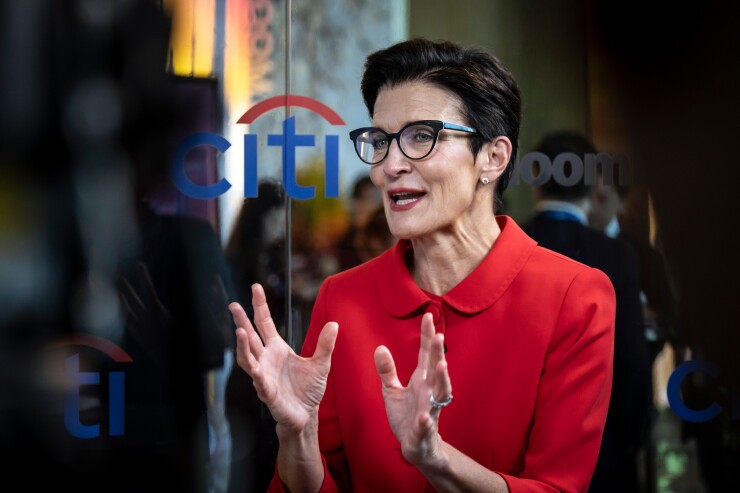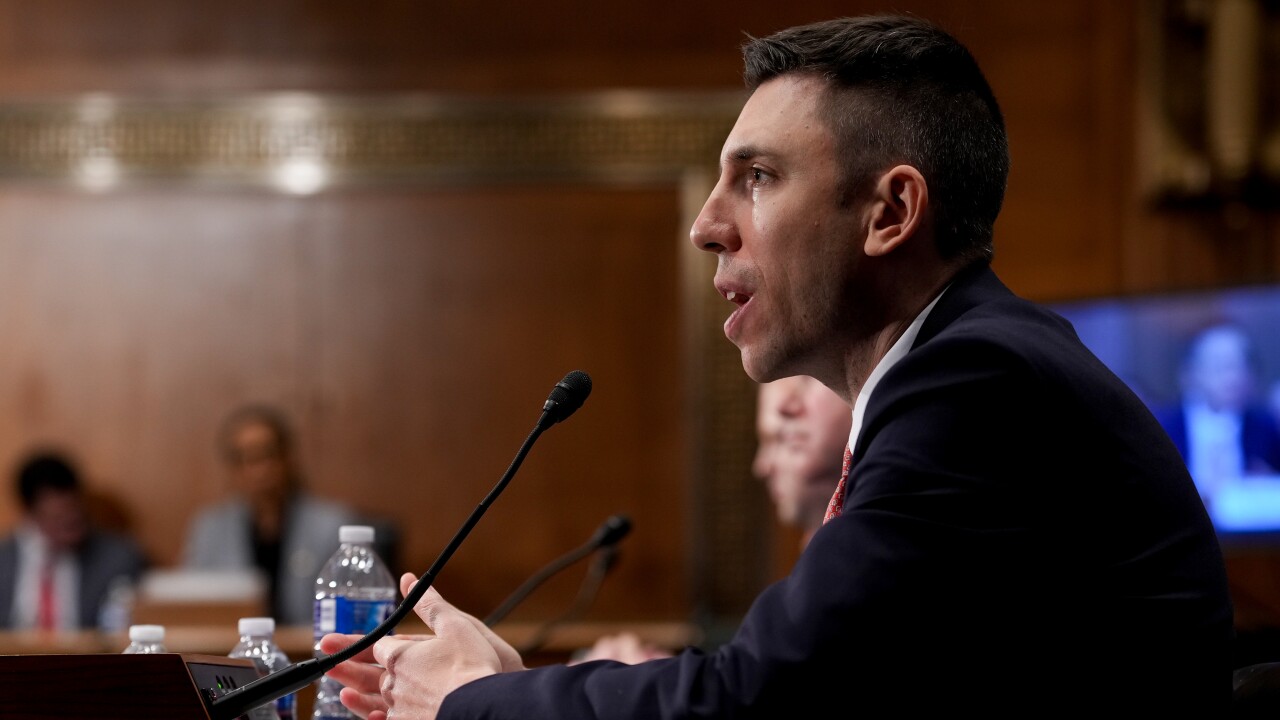- Key insight: Citi is one of a handful of banks that are seeking first-mover advantage in crypto custody, tokenized deposits and related services.
- Supporting data: BlackRock's spot bitcoin ETF crossed 800,000 bitcoin under management, worth almost $100 billion, after starting to trade in January 2024.
- Forward look: Citi is building a crypto custody platform for clients that want to invest in digital assets.
Citi is moving forward quickly with the tokenized deposit services it rolled out in late 2024 and a crypto custody service that's due to launch early next year.
"We're innovating a lot in the digital asset space," CEO Jane Fraser told a CNBC reporter in a recent interview.
It's one of a handful of large banks — including
Institutional demand for crypto services is still nascent, but it's quickly growing, according to Grace Broadbent, senior analyst at Emarketer. For example, BlackRock's spot bitcoin ETF crossed 800,000 bitcoin under management in October, worth almost $100 billion, after starting to trade in January 2024.
Citi wants to be a one-stop-shop custodian, Fraser said. "We are the leading custodian in the world," she said. "We just did a pilot where we were moving Ethereum for a client into our custody, holding it and returning it back again. So we're at the forefront, and we've been moving billions of dollars in digital assets."
This makes Citi one of the first banks to publicly run a live ether custody pilot.
Ether custody is "a major advancement for the legacy financial services industry," Broadbent told American Banker. "It signifies closer ties between legacy financial institutions and the digital asset world and helps to further solidify crypto's long-term future in mainstream financial services."
Citi is one of the largest global custodians but not necessarily "the singular leader," according to James Wester, research director at Javelin Strategy and Research, who noted that BNY and State Street typically rank above Citi on total assets under custody or administration.
"Citi is a top-tier player with enormous global reach, and their approach to crypto is important, but I do not know what is meant by 'the leading custodian,'" Wester told American Banker.
Most of Citi's competitors are at the proof of concept phase, Fraser said. "We're moving. We've been doing it for quite a while now, and with billions of dollars of flow," she said.
Internal liquidity movements and even settlement tests can add up quickly at a bank of Citi's size, Wester said.
"That's what makes applying digital assets and tokenized deposits to that part of the business so important: It's a massive amount of money moving around," he said. "It is likely still small relative to Citi's traditional flows, but it's meaningful as a signal of the technology becoming a part of a product offering in a large global bank like Citi."
Token Services
One of Citi's major digital asset initiatives to date is its Token Services program, which was one of
Asked why the bank is excited about tokenized deposits, Fraser spoke of clients that do business internationally.
"It comes back to, what does the client need," Fraser said. "A client wants to move money around the world instantaneously, 24/7, 365 days a year, safely and without hassle and complexity. And that's what tokenization does. Tokenization digitizes entire markets. And we've been working on making sure that we can serve that use case from the clients."
Heiko Nix, head of cash management at German technology company Siemens AG, said Citi Token Services has enabled a "real-time treasury transformation at Siemens," providing support for near-instant funding and liquidity management and enabling cross-border transfers, in a video on Citi's website.
Siemens operates in 50 countries and manages more than 300 bank accounts in 40 currencies, Nix said.
"One important milestone was the integration of Citi's Token Services for our instant funding and liquidity management," Nix said in the video. "Leveraging our existing account structure made the implementation efficient and straightforward. With this setup, we can access and deploy global liquidity in real time, enabling 24/7 cross-border transfers beyond the limit of local cutoff times. Citi's API suite is fully embedded in our internal system, giving us real-time bank account access and instant payment execution. This brings higher automation, improved transparency, and a treasury setup that is more responsive to today's dynamic demands."
Citi recently added an additional currency, the Euro, to the service, and expanded the platform to include Dublin, Ireland. The bank already supports U.S. dollars, British pounds and Hong Kong and Singapore dollars.
For a global bank, tokenized deposits are at the very least "leading edge," Wester said.
"Citi is one of the few trying to run a real network rather than isolated pilots," he said.
He also sees demand across certain use cases, such as large multinationals that want 24/7 settlement, reduced intraday liquidity constraints and simpler cross-border flows.
"This market is early, though," Wester said. "The demand is strongest among more sophisticated treasury groups already pushing for real-time infrastructure, not across the entire corporate base. But it's a good start."
Citi clients that use Token Services are typically global Fortune 500 companies that keep money at Citi branches around the world, Bis Chatterjee, global head of partnerships and innovation at Citi, told American Banker.
"More and more of these entities move dollars around across their multiple bank accounts because liquidity facilitates payments," Chatterjee said. "So anytime they have to make settlements, liquidity is extremely important."
In the past, these clients have manually tracked this movement of money. At the same time, some are working with digital marketplaces or global supply chains with suppliers based in different locations, making their need to manage liquidity on a global basis more dire.
"What we would constantly hear from them is a request to push cut-off times," Chatterjee said. "Can you move it from six o'clock to seven o'clock? Can you move it from seven o'clock to eight o'clock? So the initial use case that we went to market with was to give these global treasurers that had multiple accounts with us in multiple jurisdictions an ability to move liquidity around the Citi ecosystem so that they didn't have to deal with these requests for pushing cut-off times."
Holiday calendars were also an issue for international companies, he said. The fact that countries observe different holidays causes mismatches on top of time zone issues.
"People were doing things like, when New York would close for the evening, they would take a chunk of liquidity and send it to Asia over the weekend, so that on Monday morning, when Asia opened, they would have enough funds," Chatterjee said. "They would have to estimate how much money they would need Monday morning. If Monday morning Singapore time, which is Sunday night in the U.S., they suddenly realized that they needed more funds, they could initiate a transfer on demand, rather than rely on pre-positioning."
Another use case is securities clearing. When the U.S. securities market moved from T+2 to T+1 settlement, Citi had broker-dealer clients overseas that trade U.S. securities in dollars who had difficulty shifting their operations. Because of the time zone difference and because of the shift to T+1, it was hard for them to predict what the trading day would look like, especially on days of volatile, high volume trading. They began using Citi Token Services to facilitate moving money instantly around the world rather than forecasting how much money they would need in advance.
Mergers and acquisitions are another use case. "You know that the transaction will close and what the amount will be, but as soon as it closes, you're supposed to make all kinds of good faith payments," Chatterjee said. "So we're seeing the use case morph from the original global Treasury model to people that need money on demand. We've had good traction with e-commerce marketplace players that are based in one location, who have suppliers in another location. Their platforms operate on a 24/7 basis, so they've been using these flows."
Recently Chatterjee's team started thinking about what happens when a Citi client wants to interact with a supplier who doesn't bank with Citi. To remedy this, the bank began offering Citi Token services and 24/7 clearing to about 250 to 300 banks.
"That's added 270 banks that we can move money [to]," Fraser said. "So it's not just within the Citi system, but it's also to other banks that we can move instantaneously 24/7 without complexity."
One of the biggest differentiators for Citi, in Chatterjee's view, is that it's not forcing clients to build additional technology or upgrade what they have.
"We're using the same access points that they have into us, whether it's through our online banking portal or through our API portal, and we're able to then say, look, you have the same access point, you have the same methods of connecting," Chatterjee said. "You don't have to do anything. We're going to abstract all the complexities of these new technologies and connections at our end, you just get to see the benefits of it."
Citi's pitch that it abstracts the blockchain layer and makes Token Services easy to connect to should appeal to clients, Wester said.
"Their corporate clients don't want to rebuild treasury plumbing just to test a new settlement rail," he said. "Where I think there are some nuances is in the claim that clients won't have to do anything. That is rarely the case. Treasury clients will still need to update workflows, reporting, reconciliations and controls. But the core idea that customers don't have to worry about no new pipes or integrations is completely credible and a solid message."
Why tokenize?
The reason Citi can't just move money around the world for clients without tokenizing their deposits is because within the banking system, banks have finite pools of liquidity, Chatterjee explained.
"In New York time, our bank allocates a certain amount of liquidity to the New York branch, so transactions through New York can be settled," he said. "Similarly in Hong Kong, our bank treasury allocates a certain amount of U.S. dollar liquidity for transactions in U.S. dollars to settle." This is true for all banks, he said.
"This is the reason why you have cut-off times, because you need to square your books, understand how much liquidity is available, and then, if needed, transfer the liquidity to the next location so they can do that," Chatterjee said. "What tokenization allowed us to do was to get away from a batch infrastructure that operated based on certain cut-off times. Using blockchain technology and ledger technology, we established a 24/7 operating model where you didn't have to physically close down ledger posting and things like that."
The first thing Citi did was convert its branches to operate on 24/7 ledgers. Then it connected the branches through an internal blockchain network so that tokens could be transferred from one branch to another.
"So, for example, when a client has an account with us in New York and an account with us in Hong Kong, and he comes and says, move $1 million from New York to Hong Kong, we take a million dollars from their account, and we create a token, and we move the token to the New York branch account," Chatterjee said. "Then the New York branch account, through its blockchain, transfers that token to the Hong Kong branch. When the token arrives in Hong Kong, we burn the token at the branch, so we kill the token, and those funds then get released and get posted or credited to the client's Hong Kong accounts."
This is similar to the way stablecoins are created, registered on a blockchain and moved from one location to the other.
"But tokenization allows us to use the liquidity and the funds the clients have with us," Chatterjee said. "Because these funds are part of the deposit base that clients have with us, it allows us to use the liquidity when the clients need it. We don't need to segregate and hold it saying, what if, so we're not pre-funding any liquidity. We're not creating any coins in advance. So the tokens and the coins only exist when a transfer is happening. You use liquidity on demand only when you need it."
Citi's tokens are based on ethereum technology. Its private ledger is compatible with Hyperledger, an open-source project hosted by the Linux Foundation. Citi uses third-party software for anti-money-laundering checks and monitoring, but the core ledger infrastructure and token technology is all built and maintained in house, Chatterjee said.
"It's very, very standard, very, very resilient, as we've seen across the ecosystem outside, but we run it on a very private basis," Chatterjee said. Using standardized technology "gives us the optionality of creating many more use cases in the future."
The future: Crypto custody
Citi is building out a crypto custody service that it plans to roll out in 2026.
Citi's large asset manager clients have started looking to add some element of crypto to their portfolios, either as a hedge or an investment vehicle, Chatterjee said.
"Until now, most people have been using proxies — things like ETFs or structured notes," he said. "But there's a growing interest in people saying, 'Can I do it safely and securely through the underlying asset itself, rather than rely on proxy instruments and proxy exposure?' These clients are increasingly looking towards their large partner custodians, like us, to extend those services and provide a one-stop shop."
The basic building blocks for crypto custody are similar to what's needed to provide custody for deposit tokens, he said.
"A lot of the frameworks that our blockchain and our DLT Center of Excellence created are compatible and leverageable for extending it to crypto assets," Chatterjee said. "So the networks that you use internally, the token technology, the wallet technology are exactly the same frameworks that you use now. There are some differences, like the fact that now you're going to interact with an external blockchain."
Crypto custody calls for some new technology elements like digital wallet technology, key management technology, hot and cold storage and connectivity to external blockchains.
"We have been working for a few years on developing those capabilities and integrating them into the rest of our traditional custody systems," Chatterjee said. As it did with Token Services, Citi is trying to make crypto custody compatible with its existing custody services.
The Office of the Comptroller of the Currency recently released an interpretive letter confirming that national banks can hold crypto assets and pay network fees related to permissible banking activities.
The interpretive letter gives banks like Citi the confidence to launch crypto custody services along with other crypto services, Broadbent said. "It signals the U.S. is OK with banks handling crypto as long as it's done in a safe and transparent manner."
Every incremental piece of clarity "reduces friction for banks looking at digital-asset activities," Wester said. "It doesn't mean that offering these services will jump-start demand. It does lower perceived regulatory risk, however, and makes internal conversations between product, risk, compliance, governance and other internal stakeholders easier. Banks won't scale these offerings without clear supervisory comfort, so any interpretive guidance helps."






